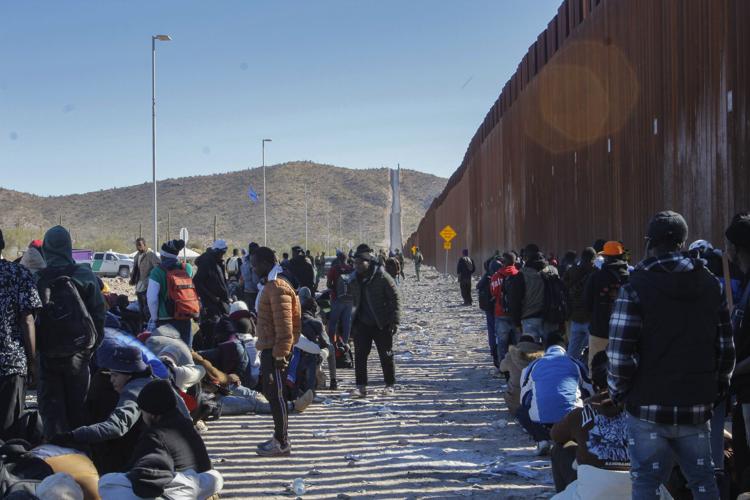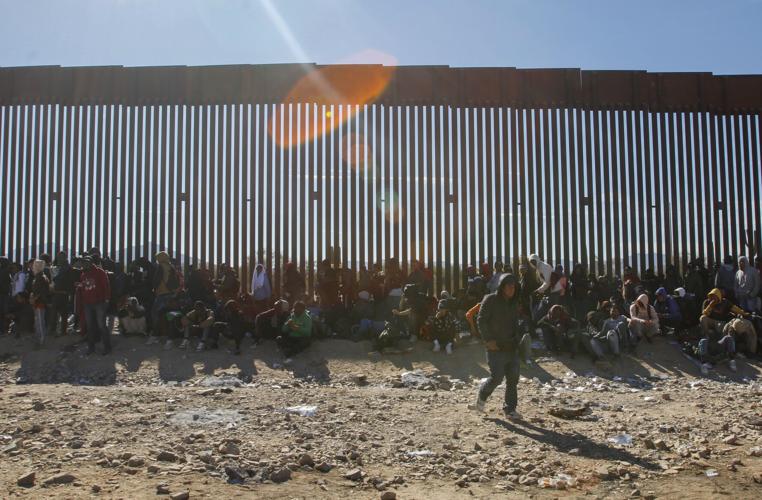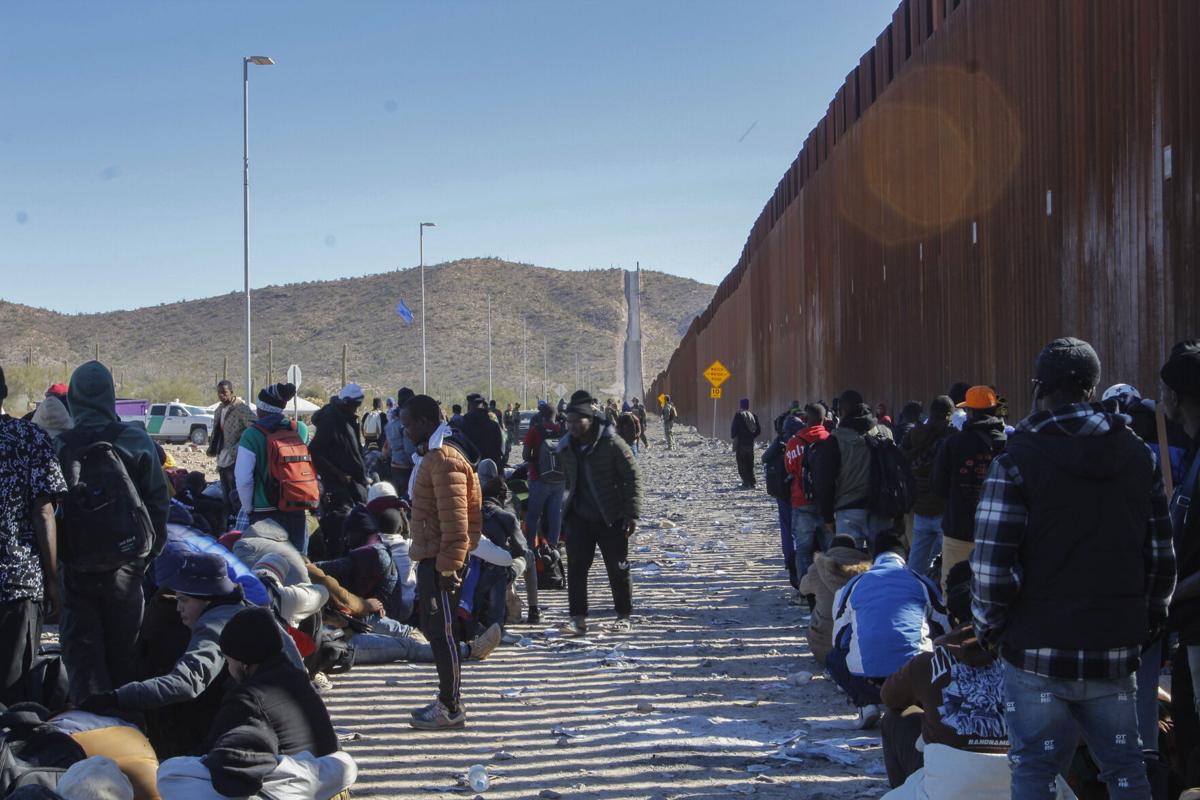Mexican officials in Sonora say they are taking steps to help slow the unrelenting surge in unauthorized migrant crossings in the border’s Tucson sector, in hopes of a quicker reopening of the shuttered Lukeville, Arizona, port of entry.
But legal advocates for migrants say the most effective solution — bolstering legitimate avenues to request asylum at U.S. ports of entry, rather than funneling migrants to hard-to-reach, dangerous parts of the border — has still been largely ignored by U.S. leadership.
This week, three Sonoran mayors — Jorge Pivac of Puerto Peñasco, Abraham Mier of Caborca and Luis Enrique Valdez of Sonoyta — held a strategic meeting with Mexican state leaders, as well as military and federal immigration authorities, to discuss how to reduce the pressure on U.S. border agents near the Lukeville-Sonoyta port of entry, said Martín Martínez, tourism secretary for Sonoran beach destination Puerto Peñasco, known as “Rocky Point” in Arizona.
Strategies include devoting more resources to checkpoints and “migration filters” in Sonora, where staff would try to redirect Arizona-bound migrants to shelters in Sonora. The government would also provide buses and create temporary shelters. There, migrants could request an asylum appointment through the Biden administration’s “CBP One” app and await their appointment south of the border.
That would hopefully reduce the number of people who resort to crossing the U.S.-Mexico border between ports of entry before surrendering to border agents, Martínez said.
The Sonoran mayors held a separate meeting on Monday with the Lukeville port director, Peter J. Bachalier, to discuss those strategies, Martínez said.
“Everybody is looking at what can we do to assist,” he said. “We’re hoping that it actually helps, if they see less people getting in. ... We want that border open.”

The shuttered Lukeville, Arizona, port of entry was quiet and empty on Tuesday. Just a few miles to the west, hundreds of asylum seekers waited to be processed by border agents.
A U.S. Customs and Border Protection spokesman on Wednesday confirmed the meeting between Bachalier and local Sonoran officials, but could not comment on what was discussed.
The surge of migrant arrivals near Lukeville, about 150 miles southwest of Tucson, prompted the temporary yet indefinite closure of the Lukeville port on Monday, and the reassignment of more than 20 port officers into the field, to assist border agents with migrant processing, CBP announced last week.
Those port officers have been reassigned directly to the nearby Ajo Border Patrol station, about 38 miles north of Lukeville, to support border agents in the Lukeville area, CBP spokesman John Mennell said Wednesday.
Border agents and migrant-aid workers told the Arizona Daily Star this week that the additional manpower at the border wall near Lukeville appears to have already improved agents’ ability to transport migrants from the remote area to official processing sites. But with the continued arrival of more than 1,000 migrants a day in this region, the situation is far from under control, they say.
Many critics, including Arizona legislators, Tohono O’odham Nation leadership and Gov. Katie Hobbs, have decried the port closure as unnecessary and damaging to the economies of the small communities on both sides of the border that rely on cross-border commerce.
Misguided solutions
Legal advocates criticized the plan to simply redirect migrants to shelters in Mexico, which are already overwhelmed, and to compel asylum seekers to rely solely on inadequate tools, like the CBP One app, to exercise their legal right to request asylum.
“There isn’t enough shelter space available to house the number of people that are actually stuck there in the Lukeville area,” said Alba Jaramillo, co-director of the Immigration Law & Justice Network in Tucson. She also provides legal services for Casa de la Misericordia, a migrant-aid shelter in Nogales, Sonora.
Migrants awaiting the chance to request asylum face violence and extortion in Mexico, both from criminal groups and Mexican authorities, Jaramillo said.
In one government-run shelter in Nogales, Sonora, authorities have a list determining which migrants get the chance to approach the DeConcini port of entry and request asylum, she said. Desperate migrants, waiting months for their chance, have told aid workers that they were charged $1,000 to get their name higher on the list, she said.
Pedro De Velasco of Kino Border Initiative said he’s heard the same thing from asylum seekers at Kino’s migrant resource center in Nogales, Sonora.
But it’s not clear whether it’s Mexican authorities extorting the migrants, or unofficial helpers who are managing the list, said De Velasco, director of education and advocacy for Kino Border Initiative, which offers food, shelter, legal assistance, psychological support and other services to migrants.

On Tuesday, the border wall just west of the shuttered Lukeville, Arizona, port of entry, 150 miles southwest of Tucson, was crowded with about 500 asylum seekers awaiting processing by Border Patrol agents.
Advocates have criticized the CBP One app for having far too few available appointments for the crushing number of asylum seekers arriving at the U.S. border.
Across the entire southern border, U.S. port officials processed about 1,460 people with CBP One appointments each day in October, CBP data show. In Nogales, that’s meant about 100 appointments have been given out daily in recent months, Jaramillo said.
Asylum seekers are waiting as long as six months to get an appointment through the app, adding even more strain to the maxed-out shelters housing them in Mexico.
One of the root causes of the surge in asylum seekers between ports of entry is the lack of legitimate, timely ways to request asylum and the chronically underfunded, overburdened U.S. asylum system, Jaramillo said.
Throwing more money at the border wall, which only results in a higher number of migrant deaths in the desert, is a waste of federal funds and migrant lives, she said.
Resources should be directed to bolstering the asylum system, so that there are enough judges to hear the massive backlog of asylum cases, and enough asylum officers to meet with migrants about their petitions, she said.
Aid workers met with Tucson sector Border Patrol leadership over the summer to discuss how to deal with the expected increase in asylum seekers after the expiration of the restrictive pandemic-era Title 42 policy, De Velasco said.
At that time, agents discussed the challenges in moving large number of migrants from remote regions like Lukeville, about 2.5 hours from Tucson, he said. Aid workers suggested improving access to the ports of entry, where transportation to processing stations, humanitarian aid and respite services in Tucson and Phoenix is readily available, he said.
“You already have all these mechanisms in place to receive migrants, but not in those remotes areas,” he said. “Border Patrol is always saying, ‘We’re here to stop terrorism, to fight drug smuggling.’ But (lately), they’re like kind of like an Uber service from the middle of nowhere into one of these cities.”
On the border
Asylum seekers, arriving by the hundreds in the Lukeville area, and further east of Sásabe, Arizona, are facing days-long waits, in bitter-cold temperatures, as border agents struggle to process them and transport them to CBP facilities.
Migrants who are deemed to have a credible fear of persecution in their home country can be transported to migrant-aid shelters in Tucson or Phoenix, like Casa Alitas, where they can rest before traveling to sponsors in other cities and awaiting their asylum hearings.
Most asylum seekers leave Tucson within a day or two, aid workers say.
On Tuesday about 500 migrants, primarily from Africa, India and Latin America, waited near Border Patrol officers just west of the Lukeville port of entry. Most crossed the border through holes cut in the wall further to the west. The travelers reported waiting days in the cold, without access to food, hoping for the chance to request asylum.
All of the migrants waiting on Tuesday afternoon were men, as the women and children on site that morning had already been taken to a staging area near the port of entry. There, agents search migrants’ bags and clothing for contraband, before they are sent to the Ajo processing station.

A border agent tosses a backpack to a migrant awaiting processing on Tuesday at a staging area near the shuttered Lukeville, Ariz., port of entry, 150 miles southwest of Tucson. On Tuesday afternoon, the border wall in this area was crowded with about 500 asylum seekers awaiting processing by Border Patrol agents.
Humane Borders volunteers say agents at Lukeville have prohibited them from distributing food to migrants in recent days, for fear that a riot could break out among the increasingly desperate asylum seekers waiting there.
Dan Abbott, who has been volunteering with Humane Borders for almost 20 years, said they were allowed to distribute food to migrants they met on the road, away from the crowds at the Border Patrol holding area.
The humanitarian aid group, which routinely fills water tanks at various stations along the border, has issued a call for more volunteers and donations amidst the extraordinary surge of arrivals at the southern border.
Aid workers and the Border Patrol have historically had a tense relationship, Abbott said. But the recent surge has brought out some camaraderie between the two groups, who share the same goal, he said.
“For years, Border Patrol and aid organizations have been kind of on opposite sides,” he said. “What’s happening now is that, we’re both invested in keeping people alive.”
Relations have almost become amicable, he said.
“We’re not buddies, but we’re not getting in each others’ way,” he said. “Our basic understanding of immigration is different from theirs, but so be it. We can still work together and care for people in the meantime.”
Wall failures
On Tuesday, just west of the Lukeville port of entry, workers with CBP-contracted Spencer Construction were using welding tools to repair one of the countless gaps sawed into the border wall’s steel bollards, likely by human smugglers using battery-powered power tools.
Across the border in the Tucson sector, the border wall is spotted with repaired bollards, as well as large gaps where construction crews are replacing already failing sections of the wall, which was constructed hastily just a few years ago without adequate erosion control, particularly east of Sásabe, Arizona.
The surges in migration are primarily occurring in areas where the Trump administration built its 30-foot border wall, demonstrating the wall’s failure as a primary means of dealing with migration, said Laurie Cantillo, water-truck driver for Humane Borders.
No sooner than a gap in the wall is closed, it’s quickly reopened again — and again.
“One welder told us he has job security for life,” Cantillo said. “Smugglers have found out how to easily cut the vertical beams using metal saws. The bollards are cut as fast as welders can make repairs.”
Backlash to Lukeville closure
U.S. politicians have expressed outrage over the Lukeville port closure. Longtime U.S. Rep. Raúl Grijalva of Tucson said shifting federal dollars to other parts of the country has meant fewer resources for border states, like Arizona, “on the frontlines of the humanitarian crisis.” Grijalva said the small number of officers reassigned from the Lukeville port will make “a marginal impact.”

The shuttered Lukeville, Arizona, port of entry was quiet and empty on Tuesday. Just a few miles to the west, hundreds of asylum seekers waited to be processed by border agents.
“We require an immediate surge in resources and staffing in southern Arizona,” Grijalva wrote in an emailed statement. “An indefinite closure of Lukeville is a major disruption to the borderland communities I represent and many across the state of Arizona.”
Tohono O’odham Nation Chairman Verlon Jose said in a statement earlier this week that closing a legal port of entry in the face of a surge in asylum seekers “makes no sense.”
“Closing this port will have immediate negative impacts on members of the Nation, and the entire region, that legally use this port for commerce, healthcare, education, and other important activities. Further, it is likely this closing will cause an increase in migrant crossings at unsanctioned areas of entry. Other legally identified ports of entry will also experience increased congestion,” the statement said.
On Sunday, Sonoran Gov. Alfonso Durazo said in a statement shared on X, formerly Twitter, that closing the border is not the way to deal with the migration crisis.
“I have sent to the United States immigration authorities, especially CBP and the American Embassy in our country and to our Foreign Ministry, the request to make all necessary efforts to continue as soon as possible with the extraordinary tourist and social commercial relationship that has historically distinguished Sonora and Arizona,” Durazo said in Spanish.
He said Sonora has made an “extraordinary and unprecedented effort in both economic and human resources to serve people in mobility situations that pass through our entity with a humanitarian approach.”
“No one can deny that the immigration issue is extremely complex, but the solution is not in the closure of border crossings,” he said. “For the good of the families that share not only filial ties, but also productive ones, trust that very soon we will be able to solve this problem.”
Contact reporter Emily Bregel at ebregel@tucson.com. On X, formerly Twitter: @EmilyBregel









